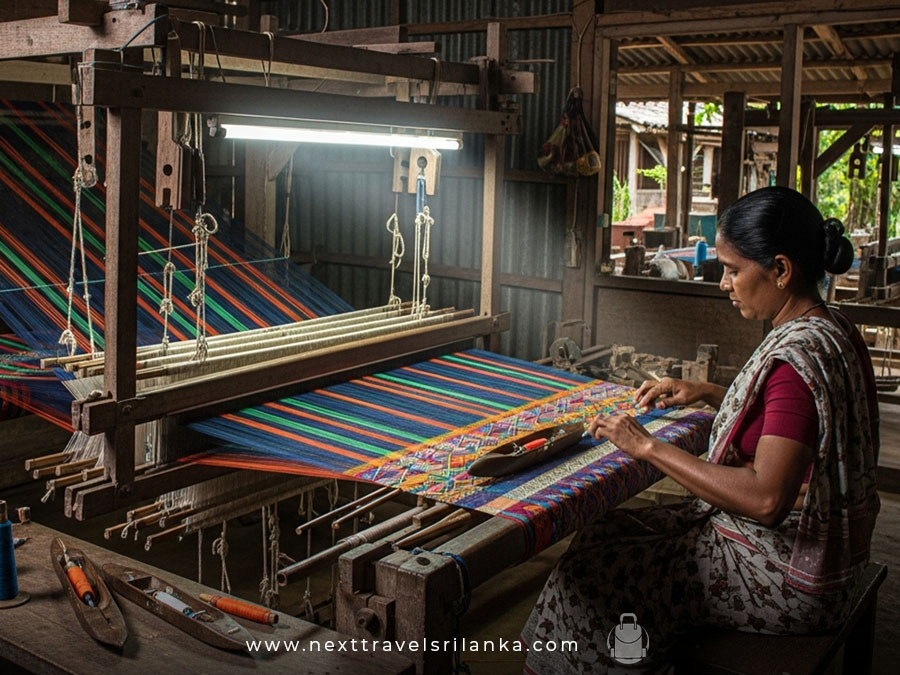
Sri Lanka, the island of the Indian Ocean, is simply a cultural treasure trove! The religious and cultural attractions it houses, the wonderful traditions that Sri Lankans practice, as well as the delicacy of the cultural industries that live strong in this tiny island, are indeed significant. Among them, the handloom industry in Sri Lanka embodies a tradition intricately woven through generations of artistry, culture, and skill. In fact, it represents more than merely a cottage industry. It narrates a tale of identity, heritage, and perseverance. Each thread crafted by Sri Lankan weavers symbolizes the island’s rich historical background and cultural diversity. From the rhythmic sound of wooden looms in household workshops to the colorful sarongs and fabrics showcased in marketplaces, handloom weaving represents a mark of national pride. Thus, the handloom industry in Sri Lanka is indeed something to know about. Continue reading to explore its beauty!
The Legacy of the Handloom Industry in Sri Lanka
The history of the handloom industry in Sri Lanka dates back over 2,500 years. As per chronicles, this industry is a gift of the Chinese and Indian traders who migrated to Sri Lanka. Over the years, artisans in Sri Lanka have improved their distinctive weaving methods and patterns, setting them apart from other Asian styles. Moreover, with the use of locally harvested cotton, silk, and natural dyes, the Sri Lankans have been able to create a unique identity in the handloom industry that is both genuine and eco-friendly.
Besides, it is clear that the handloom industry in Sri Lanka flourished under the support of royalty during ancient times. In fact, the members of royal families and nobles have frequently commissioned exquisite woven fabrics to use in ceremonies, festivals, and religious ceremonies. While this tradition has transformed, the core essence of craftsmanship has remained constant. In today’s world, handloom weaving has evolved to align with modern trends while still maintaining its traditional foundations.
Moreover, the allure of Sri Lankan handlooms is visible in their genuineness. They are unique in every way. The villagers craft each of these items by hand. Thus, we can assure that there are no two pieces ever alike. Observing how the villagers weave them, as well as studying the creativity of these handlooms, is simply interesting. So, for travelers seeking to explore Sri Lanka beyond beaches and temples, discovering the beauty of the handloom industry in Sri Lanka will surely offer a window into the island’s creative soul.
The Art of Weaving Handloom
Handloom fabric production is a delicate technique that calls for talent and patience. The first step is spinning yarn. Mostly, villagers perform this task by hand using basic tools. However, some villagers now even use semi-mechanized spinning. After that, the crafters color the yarn, frequently using natural substances like indigo, turmeric, and coconut husk extracts, which give Sri Lankan textiles their distinctively bright and earthy hues.
After coloring them, the crafters put them on the loom, where the shuttle’s rhythmic motion creates patterns. Mostly women from rural areas, the weavers expertly turn simple threads into exquisite textiles adorned with designs influenced by local folklore, heritage, and the natural world. Common patterns that combine creativity and tradition include stripes, geometric shapes, and shaded themes.
Each piece of handloom fabric has a tale to tell, reflecting both the village culture and the artisan’s life. Even though it takes a lot of work, the process gives everyone involved a great deal of happiness. Observing the weaving process can be an enthralling and contemplative experience for those that visit these villages. It links them to a calmer, more purposeful lifestyle in which every creation is made with love and intention.
The end result frequently takes the form of wall hangings, table runners, shawls, sarees, and sarongs that bear the warmth of the hands that created them. For travelers, buying these fabrics directly from weavers supports local livelihoods. It is also a reason for the continuity of the traditional skills that have been passed down through generations.
Handloom Villages and Tourism
Handloom weaving is an experience rather than just a craft. Many handloom villages in Sri Lanka welcome visitors who are keen to see this age-old craft in action. You can find some of these vibrant weaving communities around Hikkaduwa, Marawila, and Thalagune in Kandy. Local customs have inspired the color schemes, weaving techniques, and design patterns unique to each region.
Visitors to these communities get the opportunity to watch craftspeople at work on wooden looms, participate in dyeing demonstrations, and even attempt weaving a tiny piece themselves. Because of these engaging experiences, handloom tourism is becoming more and more popular in Sri Lanka’s cultural travel market. It gives visitors insight into the ways that culture and livelihood interwinds and allows them to form meaningful connections with local people.
The significance of marketing handloom villages as heritage attractions has been acknowledged by the government and the Sri Lanka Tourism Board. Besides, owing to the fact that a significant portion of the weavers in these areas are women, they not only display traditional artistry but also empower women. Their efforts help communities prosper and preserve the nation’s cultural heritage while making a substantial contribution to the rural economy.
Additionally, visitors and residents can view and buy genuine Sri Lankan textiles at handloom fairs and exhibitions. They are mostly held in around Colombo and Kandy. Travelers can witness the brilliance of each creation and bring a bit of Sri Lanka’s culture home with them thanks to these activities.
Sustainability and the Modern Revival of the Handloom Industry in Sri Lanka
Sri Lanka’s handloom sector is a brilliant example of environmentally responsible handicraft in a world where ethical production and sustainability are becoming more and more important. The procedure generates nearly no trash, employs biodegradable pigments, and requires very little electricity. Various workshops use organic cotton and natural dyeing techniques. They are indeed bringing historic customs into line with contemporary environmental ideals.
Besides, the handloom business has seen a resurgence due to the increased global awareness of slow fashion. Today, rural weavers work alongside local designers and business people to produce contemporary designs that appeal to both domestic and foreign consumers. By providing fashionable and environmentally friendly items, this partnership has assisted in bridging the gap between tradition and trend.
Moreover, travelers are growing increasingly aware of the consequences of their purchases. In fact, it is now a popular fact that choosing handloom products supports ethical fashion while promoting local culture. Thus, many tourists view it as a way of making the world a more equitable and greener place. Accordingly, in addition to providing a cultural experience, visiting handloom facilities helps further the global trend toward responsible tourism.
Additionally, workshops teaching weaving to younger generations have been sparked by the handloom renaissance. These programs guarantee the transmission of knowledge about this age-old craft. Witnessing this renaissance gives visitors to Sri Lanka a greater understanding of how ancient customs can be exquisitely modified to meet contemporary demands.
Handloom Industry and the Cultural Identity in Sri Lanka
Sri Lankan handloom fabrics are beautiful not just because of their designs but also because of the tales they tell. Every area creates designs that reflect its cultural heritage. In the hill country, cold colors are frequently visible with the geometric patterns. There is a belied that they reflect the tropical environment around the coasts.
Moreover, the Sri Lankan customs and daily life hold a strong link with the handloom textiles. Traditional clothing, handmade mats, and sarongs continue to be comforting and proudly symbolic. Most Sri Lankans wear handlooms in religious ceremonies, marriages, and festivals, emphasizing the link between fabric and identity.
Besides, these colorful creations frequently enthrall tourists visiting Sri Lanka. In addition to being aesthetically pleasing, handloom fabrics stand for the principles of community, sustainability, and simplicity. Purchasing such goods allows one to help those who work to preserve Sri Lanka’s heritage while also celebrating it.
Authenticity is the foundation of cultural tourism, and few things are more genuine than touring a handloom workshop where each item showcases the individuality and inventiveness of the weaver. What distinguishes Sri Lankan handlooms from mass-produced textiles is their human touch. In fact, the patterns of handlooms are reflections of time, nature, and life rather than merely designs.
Future Prospect and Global Recognition of the Handloom Industry in Sri Lanka
The handloom industry in Sri Lanka appears to have a bright future. In fact, the demand for sustainable and handcrafted goods is rising globally, which gives the nation’s weavers new opportunities. Training, technological advancements, and international marketing are some of the ways that the public and commercial sectors in Sri Lanka have started to assist this business.
But there are still difficulties. There are fewer talented craftspeople in villages as younger generations frequently migrate to cities for employment. Maintaining this skill requires striking a balance between innovation and tradition. Long-term weaving sustainability will be aided by promoting weaving to young people as a lucrative and esteemed career.
Apart from that, the handloom centers are increasingly vital components of cultural itineraries for the tourism sector. Traveling through Sri Lanka’s countryside allows visitors to learn about the island’s heart from its weavers. These encounters emphasize how crucial it is to conserve traditional arts while welcoming advancement.
Moreover, the Sri Lankan handlooms are already well-known throughout the world for their excellence and genuineness. The export markets in Asia and Europe highly recognize the creativity of these textiles. Sri Lanka’s handloom tradition is in a prime position to flourish as the global market moves toward handmade goods and ethical fashion.
When tourists purchase a piece of Sri Lankan handloom fabric, they are bringing with them a tale of culture, artistry, and nurturing. Every thread that a local craftsperson weaves ties the maker to the globe and the past to the present.
Conclusion
The handloom industry in Sri Lanka is an enduring example of sustainable creativity and cultural pride. It encompasses more than just textiles. It is an artistic, historical, and personal manifestation. Its legacy stands out as the globe shifts toward more conscientious choices. Contributing to it entails honoring the hues, designs, and legends that make Sri Lanka so unique while also protecting a portion of its traditions.
So, if you are also planning to visit Sri Lanka, don’t forget to explore the wonder of this handloom industry. From modest village workshops to global displays, the craft continues to evoke respect and adoration. Travelers can experience Sri Lanka’s creative heart by learning about its handloom heritage. It serves as a reminder that honesty is the foundation of great beauty and that each braided thread has a meaningful backstory. Happy and safe traveling!


